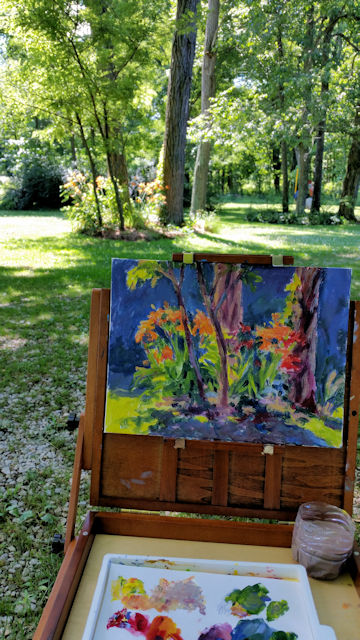One thing that has concerned me since I first became a professional painter (over 35 years now) is the quality of the materials that I use and how to make sure my art lasts. This is important to me not because of my ego but to ensure that my customers can expect a painting to last for years, even decades or centuries with proper handling. I educated myself early on about the greatest causes for deteriorating artwork, especially works on paper.
Some of the greatest causes for paintings to fade or change are:
- Sunlight! Yes, while the sun is great for so many things, it is not good for paints or papers. Even over a long period of time, it will fade the colors and break down the fibers of the paper or canvas. Sun will even fade wood over time.
- Damp enviroments invite mold and organic changes to the supports.
- Insect damage. Those little silverfish love to eat paper.
- Using cheap materials. This is my personal pet peeve. Why put all the time and effort into creating a work of art and use cheap materials? Doesn’t make any sense to me.
What can you do as an artist or art owner?
- Always choose the best materials you can afford. For instance, if you’re an artist, use artist-grade paints rather than studio or student-grade paints. The artist-grade paints contain more pigment and better quality.
- If you’re creating works on paper, use 100% rag, linen, or cotton fiber. These will hold up decades longer than pulp papers. Wood pulp contains chemicals which deteriorate almost immediately. Remember that pile of yellowed newspapers in the garage?
- Ensure that the matting and framing is archival or museum-grade. I always use museum rag mats and archival backing. If the work is under glass, you can help prevent sun damage by using UV filtering glass.
So, if you are an artist, take pride in your work and make it with the best materials you can afford. If you are an art collector, ask the artist or gallery about the materials or framing. If it isn’t framed, have your framing shop frame it archivally.
My personal experiment.
Many years ago I decided to test my materials by putting samples in a south-facing window of my studio. Both of the samples shown are on 100% cotton rag paper.

This was the test. Two pieces of Arches 100% cotton rag with ink and paint samples in a south facing window
I was testing four things.
- How well the paper withstood the direct sunlight.
- How the watercolor paints held up.
- If there was fading to the computer printed color paints.
- If any of the commercially available inks and ink pens held up to the sun.
The time frame for this experiment has been about fifteen years. I folded the art pieces over and they have just been sitting in the window for that long.

This is the outside of the mini watercolor painting. I was surprised that the red didn’t fade over 15 years. It is usually pretty fugitive.

Each piece was folded over with part of the experiment covered by the fold. In this case, it was an old mini painting. As you can see, the actual watercolor paint held up pretty well.

On the inside of this piece, I tested several commercially available pens as well as the standard India ink. Some faded totally away while some others held up surprisingly well.
As you can see, there is some small damage to the paper along the edges. I attribute this mostly due to water damage from condensation of the window, not to direct sun.
The watercolor paints (Winsor and Newton) held up surprisingly well. I was somewhat surprised that the reds held because that is a color that has a great tendency to fade.
And the pen inks. What can I say? Some, like the Zeb Roller Ink totally faded. But others, like the old standby India ink and newer Vision Elite haven’t changed at all. That is good news. I’m now testing a carbon ink from Japan and have high expectations for that.

In this test piece, I printed color ink from my computer onto rag paper. Pretty faded, eh?

The fading is even more noticeable when the covered part is revealed. Note to self: don’t use standard office printers for original artwork.
The computer printed paper totally faded. So much for archival inks. My experience has been that the black computer ink will last but not the colors, however, inks may have changed over the years. And I’m sure that commercial-grade printers and ink will fare better. But best to ask if you are purchasing a print.
The takeaway is to use or buy quality art materials and frame them in a way that will prevent damage, particularly from sunlight.
Please note: I am not a scientist so this was just a personal experiment. Use your own judgement in the end. Check out this article from scientists who are actually fixing old artwork. https://www.livescience.com/13536-winslow-homer-van-gogh-fugitive-art.html

























